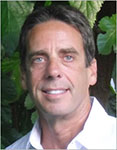Seafloor geomorphology and submarine landslide hazards along the continental slope in the Carnarvon Basin, Exmouth Plateau, North West Shelf, Australia
James Hengesh A , James K. Dirstein B and Alistair J. Stanley BA The University of Western Australia
B Total Depth Pty Ltd
The APPEA Journal 52(1) 493-512 https://doi.org/10.1071/AJ11039
Published: 2012
Abstract
3D exploration seismic data were interpreted to investigate the locations and characteristics of submarine slope failures along the continental slope in the offshore Carnarvon Basin on Australia’s North West Shelf. Seisnetics™, a patented genetic algorithm was used to process the 3D seismic data to extract virtually all trough and peak surfaces in an unbiased and automated manner. The extracted surfaces were combined in the 3D visual database to develop a seafloor digital terrain model that extends from the continental slope to the Exmouth Plateau. The 3D data were used to map the subsurface extent and geometry of landslide failure planes, as well as to estimate the thickness and volumes of slide deposits. This paper describes the geomorphic characteristics of five of the survey areas.
Geomorphic mapping shows the presence of slope failures ranging from small (20 km across) mass transport complexes (MTC). The features are associated with debris flow chutes, turbidity flow channels, and debris fields. Analysis of failure planes show prominent grooves or striations related to the mobilisation of slide material down both the continental slope and Exmouth Plateau and into the Kangaroo Syncline.
Submarine slope failures can occur at the continental shelf break in about 200–300 m of water and run out to the Exmouth Plateau surface in about 1,100–1,400 m water depths. The largest individual slides in the survey areas have widths of 30 km and minimum run-out lengths of 75 km, though associated turbidity flow deposits likely extend much further. The subsurface expression of the large MTCs illustrates a history of sediment accumulation along the mid-slope followed by repeated slope failure and debris run-out.
Sediment accumulation and slope failure processes are actively occurring along the continental slope and submarine landslides thus are a major driver of hazard to subsea infrastructure development. Smaller more frequent slides may pose a greater hazard than large infrequent MTCs.

James Hengesh has 25 years’ experience characterising geological and seismic hazards for critical infrastructure projects worldwide. He has been funded by the U.S. Geological Survey as part of the National Earthquake Hazard Reduction Program, has been an invited member of several National Science Foundation Learning From Earthquakes Program post-earthquake reconnaissance teams, and was a contributor to a recent book, Geomorphology for Engineers. He is now a Research Fellow at the UWA Centre for Offshore Foundation Systems working on a WA:ERA funded project to assess seafloor stability on the North West Shelf. james.hengesh@uwa.edu.au |

James K. Dirstein founded Total Depth Pty Ltd in 1993 and has more than 30 years’ international experience in the acquisition, processing and interpretation of seismic data from a many different sedimentary basins. His career has included many different types of exploration projects that have targeted petroleum, coal, CBM, tight gas and geothermal resources. He has a passion for the evaluation and integration of new and existing technology into corporate workflows. In his career Jim has been involved with the early application of many advanced geophysical techniques. He studied geology and geophysics at the University of Toronto and graduated with an HBSc in 1980. Member: SEG, PESA, ASEG, EAGE, SEPM, AAPG. jim@td.iinet.net.au |

Alistair J. Stanley studied natural sciences, majoring in geology at Durham University and graduated with a BSc in 2009. Since graduating, Alistair has gained experience in the oil industry with Pinemont Technologies working on airborne exploration projects and Total Depth Pty Ltd. His work with Total Depth Pty Ltd has included the processing and interpretation of seismic data from a variety of sedimentary basins across Australia for both petroleum and coal exploration projects. He has also been assisting with the development of the pre-interpretation processing technology Seisnetics™ and has actively contributed to its application in both academic research projects and corporate workflows. alistair@totaldepth.com.au |


